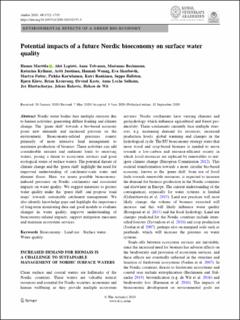| dc.contributor.author | Marttila, Hannu | |
| dc.contributor.author | Lepistö, Ahti | |
| dc.contributor.author | Tolvanen, Anne | |
| dc.contributor.author | Bechmann, Marianne | |
| dc.contributor.author | Kyllmar, Katarina | |
| dc.contributor.author | Juutinen, Artti | |
| dc.contributor.author | Wenng, Hannah Tabea | |
| dc.contributor.author | Skarbøvik, Eva | |
| dc.contributor.author | Futter, Martyn | |
| dc.contributor.author | Kortelainen, Pirkko | |
| dc.contributor.author | Rankinen, Katri | |
| dc.contributor.author | Hellsten, Seppo | |
| dc.contributor.author | Kløve, Bjørn | |
| dc.contributor.author | Kronvang, Brian | |
| dc.contributor.author | Kaste, Øyvind | |
| dc.contributor.author | Solheim, Anne Lyche | |
| dc.contributor.author | Bhattacharjee, Joy | |
| dc.contributor.author | Rakovic, Jelena | |
| dc.contributor.author | de Wit, Heleen | |
| dc.date.accessioned | 2020-10-01T07:21:34Z | |
| dc.date.available | 2020-10-01T07:21:34Z | |
| dc.date.created | 2020-09-25T14:11:48Z | |
| dc.date.issued | 2020 | |
| dc.identifier.citation | Ambio. 2020, 49, 1722-1735. | en_US |
| dc.identifier.issn | 0044-7447 | |
| dc.identifier.uri | https://hdl.handle.net/11250/2680618 | |
| dc.description.abstract | Nordic water bodies face multiple stressors due to human activities, generating diffuse loading and climate change. The ‘green shift’ towards a bio-based economy poses new demands and increased pressure on the environment. Bioeconomy-related pressures consist primarily of more intensive land management to maximise production of biomass. These activities can add considerable nutrient and sediment loads to receiving waters, posing a threat to ecosystem services and good ecological status of surface waters. The potential threats of climate change and the ‘green shift’ highlight the need for improved understanding of catchment-scale water and element fluxes. Here, we assess possible bioeconomy-induced pressures on Nordic catchments and associated impacts on water quality. We suggest measures to protect water quality under the ‘green shift’ and propose ‘road maps’ towards sustainable catchment management. We also identify knowledge gaps and highlight the importance of long-term monitoring data and good models to evaluate changes in water quality, improve understanding of bioeconomy-related impacts, support mitigation measures and maintain ecosystem services. | en_US |
| dc.language.iso | eng | en_US |
| dc.publisher | Springer | en_US |
| dc.rights | Navngivelse 4.0 Internasjonal | * |
| dc.rights.uri | http://creativecommons.org/licenses/by/4.0/deed.no | * |
| dc.title | Potential impacts of a future Nordic bioeconomy on surface water quality | en_US |
| dc.type | Peer reviewed | en_US |
| dc.type | Journal article | en_US |
| dc.description.version | publishedVersion | en_US |
| dc.source.pagenumber | 1722-1735 | en_US |
| dc.source.volume | 49 | en_US |
| dc.source.journal | Ambio | en_US |
| dc.identifier.doi | 10.1007/s13280-020-01355-3 | |
| dc.identifier.cristin | 1833509 | |
| dc.relation.project | Nordforsk: 82263 | en_US |
| cristin.ispublished | true | |
| cristin.fulltext | original | |
| cristin.qualitycode | 1 | |

